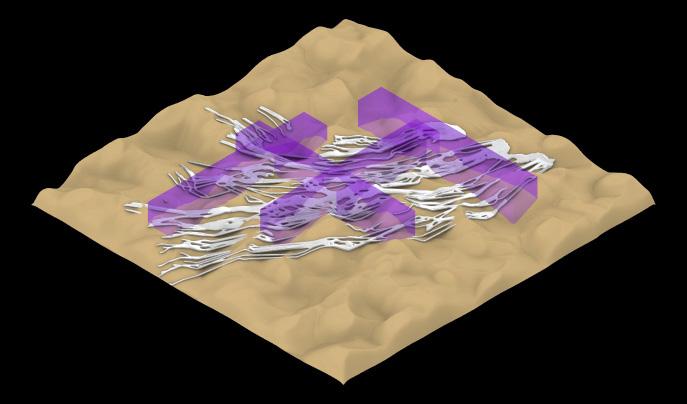
1 minute read
SAND ACCUMULATION
from AEOLIAN - AADRL
by Salim Hilles
Once agents fuse sand onto the existing landscape, the structures act as interactive obstacles. Rather than trapping, the morphology redirects sand particles away from areas at risk of wind erosion and desertification. In the first round of simulations, the terrain was covered with a single layer, and then four areas were selected for further study of sand accumulation behaviour.
As the number of layers increases over time, the complexity and performance of the structure improves. Our simulations simulate realistic desert behaviours allowing sand particles to interact with the structure’s morphology. This data is captured to evaluate the structure’s performance.
Advertisement
AREA 02 - MULTIPLE THREADS
AREA 03 - SURFACE PATTERN
Area 01 Iteration 05
In the fifth iteration, the structured network and sand accumulation are becoming more complex, leading to various effects of sand movement and space between the dunes and structures, with a higher number of particles.
This is the final iteration where the structure becomes more barriers to prevent sand from penetrating through the structure network.
The performance of the structure is influenced by two main factors: its length and the number of layers it has. In order to assess the structure’s ability to redirect sand particles away from a specific site (in this case, a circular object representing a city), the team conducted simulations in which sand was blown over three different morphologies with varying sizes: 300 meters, 600 meters, and 1,000 meters. During the first set of simulations, the 1,000-meter structure was most effective at redirecting sand, with only 0.08% of particles able to pass through it. For the second round of simulations, an additional layer was added to the smaller structures, which were partially or completely buried at this point. As a result, both sizes performed much better than they had initially. The process was repeated for a third time, with the 300-meter structure performing as well as the 1,000-meter structure in the final simulation.













